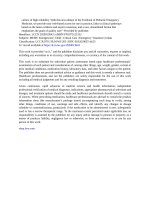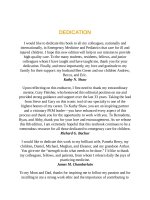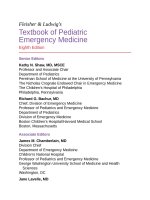Pediatric emergency medicine trisk 806
Bạn đang xem bản rút gọn của tài liệu. Xem và tải ngay bản đầy đủ của tài liệu tại đây (112.15 KB, 4 trang )
importance not to neglect the possibility of other injuries from the burn
mechanism, or associated injuries, which may also require emergent
treatment and stabilization. Finally, patients with ocular area burns will
need specialized ophthalmology consultation for evaluation of corneal
involvement.
Management
Airway. The inhalation of hot gases can burn the upper airway, leading to
progressive edema and airway obstruction. Children with burns of the face,
singed facial hairs, or hoarseness are at high risk, but airway burns can also
occur in the absence of these signs. Edema of the burned airway will
worsen over the first 24 to 48 hours. Knowledge of the time course of
airway swelling justifies endotracheal intubation for subtle signs of airway
compromise that occur shortly after the injury. Early intubation may
circumvent a difficult intubation later in the course of a child with severe
pharyngeal and airway edema. Endotracheal tubes of smaller diameter than
expected for age should be available in anticipation of a narrowed airway.
Cuffed tubes are preferred to accommodate the potential for changing
airway edema over the course of the recovery.
Children who have jumped or fallen in house fires, been burned in motor
vehicle accidents, or been burned by explosions are at risk for other
traumatic injuries, and cervical spine precautions should be maintained
during management of their airways. Furthermore, children with severe
burns may have depressed levels of consciousness for many reasons and
airway obstruction from the loss of pharyngeal tone is not uncommon.
Breathing. A rapid assessment of ventilation includes respiratory effort,
chest expansion, breath sounds, and color. Pulse oximetry is useful, but
patients with significant levels of carboxyhemoglobin will look pink and
have “normal” oxygen saturation as measured by a pulse oximeter. Children
with severe burn injury should receive 100% supplemental oxygen. Blood
gases with co-oximetry should be obtained promptly. Venous or arterial
gases can be used, although arterial samples are preferred for
hemodynamically unstable patients and to best assess degree of acidosis.
Inhalational injury can also cause damage to the lower airway. Chest
radiographs may be normal initially, even if pulmonary injury has occurred.
Mild inhalational injury can be treated with supplemental oxygen, and
consideration of albuterol or racemic epinephrine nebulizer treatment when
wheezing or stridor are present, respectively. Steroids are generally not
recommended for treatment of burn patients with airway injury, although a
single-center study showed no increased risk with a single dose. Patients
should continue to be monitored closely for any deterioration in their
clinical status. Significant inhalational injury will require endotracheal
intubation and ventilatory support.
Extensive full-thickness burns of the thorax may restrict expansion of the
chest and impair ventilation. Respiratory insufficiency in this setting is an
indication for escharotomy of the chest. Incision through the depth of the
eschar should be performed along the anterior axillary lines to allow
adequate chest expansion. If the deep burns extend to the abdomen, the
escharotomies should be extended downward and connected by incision
along the costal margin.
Circulation. The rapid assessment of circulation includes skin color,
capillary refill time, temperature of the peripheral extremities, heart rate,
and mental status. Blood pressure is often maintained until late in the course
of shock, making it an unreliable early measure. Hypertension from
increased systemic vascular resistance has been reported immediately after
severe burns, particularly in pediatric patients, and should not be taken as
an indication to discontinue proper fluid therapy.
Vascular access should be obtained soon after the arrival of the child with
severe burn injury. Peripheral, large-bore intravenous catheters are favored
because they have the lowest resistance. Catheters placed in the upper
extremity through intact skin are preferred because they are easier to secure,
but access through burned areas may be necessary. Anticipating the need for
hyperalimentation, sites for central catheter placement should be saved, if
possible. Attention to aseptic technique when starting intravenous catheters
in the emergency department (ED) can prevent infectious complications
during subsequent care. Circumferential taping is dangerous because the
swelling that occurs during the first 24 hours can cause circulatory
insufficiency distal to the constriction. Urine output is the most important
means of monitoring fluid status, but in patients with severe burns with
associated inhalational injury, central venous pressure monitoring may be
useful in the first few hours. Major burns cause decreased splanchnic blood
flow and ileus. After ensuring intact airway reflexes or that the airway is
protected by placement of an endotracheal tube, the clinician should
consider placing a nasogastric tube. Hypothermia can occur rapidly in small
children, especially in those whose skin injury impairs normal
thermoregulation. Core temperature should be monitored and the child kept
covered, except as necessary for examination and burn assessment.
Fluid Resuscitation. An initial bolus of 20 mL/kg of normal saline or Ringer
lactate solution is recommended while assessment of the extent of the burns
takes place. Fluid volume from all initial boluses including prehospital care
should be counted when calculating fluid volumes during the first 24 hours
of treatment. A urinary catheter should be placed early in the management
because there may be several hours of monitoring during transport or in the
ED during which urine production can provide clinicians with information
about fluid status.
Rapid treatment of the hypovolemia that occurs early in children with
severe thermal injuries is of prime importance. The fluid status of children
with burn injury is a dynamic process that requires careful reevaluation and
therapeutic adjustments. Extravasation of water, sodium, and protein
through abnormally permeable capillaries continues for about 24 hours after
injury. Capillary integrity then improves and intravascular volume
stabilizes. Isotonic crystalloid solutions are recommended in the
resuscitation phase. Potassium is released from damaged cells and
measured serum levels may be elevated shortly after injury; therefore,
potassium replacement is not recommended during the early phase of fluid
therapy.
Several formulas for the calculation of initial fluid therapy exist ( Table
104.2 ). The Parkland formula recommends 4 mL/kg/% of BSA of
crystalloid over the first 24 hours, half during the first 8 hours from the time
of injury and half during the next 16 hours. This formula often
underestimates the fluid needs of young children, who are also at greater
risk for hypoglycemia. Maintenance requirements using isotonic solutions
with 5% dextrose are added for patients with burns who are younger than 5
years. The Galveston Shriners formula uses BSA rather than weight to
calculate fluid therapy. Galveston Shriners recommends 5,000 mL/m2/% of
BSA, half during the first 8 hours from the time of injury and half during
the next 16 hours, plus 2,000 mL/m2/day as maintenance.
TABLE 104.2
FLUID RESUSCITATION FORMULAS
Parkland: 4 mL/kg/% of BSA second- and third-degree burns, half in the
first 8 hrs following injury, half in the next 16 hrs. Add maintenance
with 5% dextrose containing fluid in children <5 yrs old
Galveston Shriners: 5,000 mL/m2 /% of BSA second- and third-degree
burns, half in the first 8 hrs, half in the next 16 hrs. Add 2,000 mL/m2
/day maintenance with 5% dextrose containing fluid
Inadequate resuscitation can cause organ failure and death, while
overresuscitation, or excessive fluid administration, is to be avoided
because it may cause pulmonary edema and tissue edema with resultant
compartment syndrome that compromises local blood supply.
A combination of endpoints is used to ensure adequate resuscitation,
including urine output, mean arterial pressure, and biochemical markers
such as base excess and lactate. Urine output should be measured to ensure
adequate fluid resuscitation. Children should produce at least 1 mL/kg/hr of
urine. Hyperglycemia may cause an osmotic diuresis and complicate care of
the patient with burn injury. Before infusions are decreased in response to
excessive urine output, a measurement of blood glucose should be made.
Inadequate fluid resuscitation is usually manifested by oliguria. Rarely,
intrinsic renal disease is responsible for oliguria, as may occur after
electrical injuries because of myoglobinuria.
Trauma associated with burns may increase fluid requirements.
Neurogenic shock from unrecognized cervical spine or head injury may
cause hypotension, usually with a relative bradycardia. Toxins, such as
cyanide, ingested before the burn or inhaled during the fire can depress
myocardial function or vascular tone. Any patient with shock that appears
out of proportion to the extent of the burn injury, or who is poorly









